Please read the article and answer for questions That was 19
Please read the article and answer for questions.
That was 1993, the year Dave’s company, Magnetic Poetry, was born. As the idea took off, Dave realized he could no longer make the kits himself. He saved $5,000 from craft fairs and began visiting local screen-printing and die shops in Minneapolis. He paid for 1,000 prototype sets. But the road was not smooth yet. Dave knew next to nothing about distribution. He also learned that retailers are not interested in amateur packaging, and Dave’s kit looked like a cardboard jewelry box. Pam Jones, a manager of a local art museum gift shop, gave Dave lots of tips on product presentation. In three weeks, he developed a clear plastic package that Jones thought would fit on her gift shop’s shelves. By the end of that first day, she sold the 12 kits Dave gave her. The new packaging was attractive to retailers such as bookstores, gift shops in the Guggenheim and Whitney museums in New York City, and Signals catalogs. By 1994, Dave’s kits were selling in the Museum Company in the eastern part of the United States, and at the San Francisco Museum of Modern Art on the West Coast.
As time went on, Dave decided to do his own manufacturing, since he felt he wasn’t getting quick enough turnaround from his manufacturer. He went back to Murray Condon, who had helped him with his prototypes, and the two formed a separate company called Screen D’or Graphics, Inc. Kapell funded the company with the goal of a three-day order-to-delivery turnaround. He now had a number of employees in production, sales, administration, inventory control, and shipping and was looking for other opportunities for his kits, such as introducing them in foreign languages. Today, the Magnetic Poetry product line features over 100 products. Its word kits include everything from the Shakespearean, Artist, and Genius kits to the Dog Lover, Romance, and College kits. (The Original kit remains wildly popular, too.) Magnetic Poetry also has new products that go beyond the magnetic word tile genre, including a Poetry Beads kit, magnetic travel games, and Writer’s Remedy, a cookie jar filled with words to help cure writer’s block. The Web site (www .magneticpoetry.com) also offers more than a dozen kits for online play.
Polished versions of the hand-glued magnets that once decorated Dave’s refrigerator door in his Min- neapolis home now can be found on millions of such doors and metal surfaces across the country. Since Dave Kapell invented Magnetic Poetry in 1993, more than 3 million kits have been sold. Magnetic Poetry, a cultural phenomenon, has appeared in the movies Conspiracy Theory, City of Angels, and Notting Hill, as well as on Jerry Seinfeld’s refrigerator on the TV show Seinfeld.3
The Source of Business Ideas
Do you recall seeing a new product or service in a store, or maybe hearing about an idea on radio or television, and thinking, “Now, why didn’t I think of that?” In fact, most of the ideas that are turned into new businesses, or result in “new and improved” products and services, come from information and observations that we are surrounded by every day. Does it seem to you that successful business owners must possess unusual powers of observation or use top-secret strategies unknown to anybody else when seeking ideas for new businesses or innovations to their existing businesses? It’s far more likely that these people have learned to pay attention to the cues that are around them and to ask many questions of things that most people take for granted, such as the way Dave Kapell did when making Magnetic Poetry. This search and capture of new ideas that lead to business opportunities is called opportunity recognition. Researchers in the field of entrepreneurship and small business believe that opportunity recognition behavior is the most basic and important entrepreneurial behavior.4
The exact reasons why entrepreneurs seem to be better able to find ideas that work are unclear. The notion of entrepreneurial alertness is one that has captured the attention of scholars in the field. This phrase means that entrepreneurs have a special set of observational and thinking skills that help them identify good opportunities. Some scholars have suggested that entrepreneurs are able to notice things that have been overlooked, without actually launching a formal search for op- portunities.5 Others suggest that we also consider the motivations of entrepreneurs to search for new ideas.6 For example, if an owner of a fast-food restaurant notices that customers are asking for sub- stitutions of healthier ingredients to the food items, she may be motivated to contact her suppliers to ask about obtaining new ingredients and to change the menu and increase the healthy offerings on the menu to keep customers satisfied, possibly bringing in more customers.
Ideas for new businesses come from a great variety of sources. A person who desires to start a business may begin searching for opportunities that exist in the marketplace, perhaps as a way to use skills and knowledge that he or she has acquired in college or in work experience. In the nationwide Panel Study of Entrepreneurial Dynamics,7 a sample of 480 entrepreneurs were asked whether the business idea or the decision to start some kind of business came first:
But regardless of whether the idea came first or the decision to start a business came first, we now examine the factors that lead small business owners to their business idea.
Work Experience
Many successful business owners spent years working for a company and gained valuable experi- ence about how things might be done differently. Sometimes the idea grows out of listening to customer complaints.
You can use your own work and personal experiences to think of ideas for doing things differ- ently. Sometimes the best business ideas come from your own frustration or from not finding exactly what you are looking for as a consumer. Anita Roddick, founder of The Body Shop International PLC, whose 1,900 skin and body care retail stores are in 50 countries spanning 25 languages and 12 time zones,8 got the idea for her business because she was very frustrated at having to spend a lot of money on moisturizer in fancy bottles from the big name cosmetics companies. Her idea was to give customers an inexpensive, good quality product made from natural ingredients in a recyclable bottle.
A Similar Business
Even if you don’t have years of work experience in an industry or market, you might see a business in an area that intrigues you because you like certain products, or you learn that there is a growing market for this business and you think of a way to expand on the opportunity. The mini-case at the end of this chapter introduces Amy Nye Wolf, who founded AltiTUNES, a chain of airport music stores she eventually sold to Inmotion Entertainment. She got the idea for the business while travel- ing through Heathrow Airport in London while a college student.
Hobby or Personal Interest
Many people find a way to turn their hobbies into successful businesses. David and Tom Gardner, the founders of Motley Fool, didn’t start out wanting to write an online investment advice newsletter and Web site. They were avid players of a dice baseball game in high school called Strat-O-Matic, and they had a league in their town outside Washington, DC, where they grew up. Tom recalled, “It was a numbers game, and we kept lots of stats. There were so many different variables, just like the stock market and just like businesses have. And it was also a people thing, which is a big part of running a business, because all the fun of it was making trades with your competitors.”9
Chance Happening, or Serendipity
If it is true that successful business owners are alert to what goes on around them and pay attention to things most people miss, then it is no surprise to learn that another popular source for business ideas comes from the chance happening. Whether you think of it as being in the right place at the right time, as luck, or as being observant to the cues around you, many businesses have been formed as a result of the unexpected. In the early 1980s, Rangaswamy Srinivasan worked for IBM, where he worked with lasers and organic plastics. He happened to come upon his “great idea” while at the Thanksgiving table, where he wondered how effective a laser might be in slicing a turkey leg. His experiments contributed to the development of laser eye surgery, an idea that came to him by observing the environment around him. In 2002 he was inducted into the Inventors Hall of Fame.11
Family and Friends
Ideas can come to you through your conversations with your family and friends. If you are open to their suggestions, a great business idea can result. Joan Ecker, founder of The Fat Hat Factory, a $1.7 million clothing company, got the idea for making a shapeable “fat” hat when a friend told her he would visit her at her new home in Vermont only if she provided him with a warm hat.12
Education and Expertise
As we saw earlier in the chapter, some small business owners decide first that they want to own a business and then go about searching for a viable idea for that business. Often, would-be entrepreneurs look to their own skills and talents for business ideas. Consulting companies are a very popular exam- ple of this approach to business ideas. Many owners of consulting companies took their own skills and launched businesses by selling those skills to other companies or individuals who needed them. Some of these consultants were laid off or voluntarily left large employers to consult with clients because they felt their talents would be more significantly recognized and rewarded in their own businesses.
In the Panel Study of Entrepreneurial Dynamics, 480 entrepreneurs were asked, “What led to your business idea?” Figure 4.1 presents the results of this question. Work experience in a particular industry or market was the most frequently mentioned source of ideas, followed by discussion with family and friends.
Idea Sites
Today you can find Web sites where people post ideas they have and products and services they would like to see. Examples include www.halfbakery.com, www.ideabuyer.com, www.999ideas .com, www.newideatrade.com, www.marketlaunchers.com, www.inventionsforsale.com, marketplace.yet2.com, and www.coolbusinessideas.com. Spending an hour or two surfing these ideas may give you ideas of your own or suggest an invention you need to get your business going. There are also crowdfunding sites like www.kickstarter.com and www.rockethub.com, where you can post your idea and see if people will actually fund your effort to get it going.
Technology Transfer and Licensing
One powerful but rarely used source of ideas are universities and government agencies. Both develop a tremendous range of new technologies or refinements of existing technologies, but never do anything with them! Major universities and government agencies, like NASA and the Departments of Agriculture and Defense, all offer technological inventions for free to small businesses to develop. There are even govern- ment programs to help fund such efforts. A good place to start are government technology commercializa- tion sites such as NASA’s (www.nasa.gov/offices/oct/home/index.html), the Department of Defense’s site at (www.acq.osd.mil/ott/techtransit/), or the Byrd National Technology Transfer Center Web site at (iridium.nttc.edu). If you have a university nearby which has government funded research, you can contact their technology transfer office and find out about inventions available for commercialization in your own backyard, or check out the Web site of the Association of University Technology Managers at www.autm.net, or the multiuniversity iBridge Network at www.ibridgenetwork.org/.
What these organizations will offer you is an arrangement called licensing. A license is a legal agreement granting you rights to use a particular piece of intellectual property (for example, a technology). In return, you (the licensee) are required to pay the owner of the license (the licensor). These payments can consist of an upfront or annual flat licensing fee or a royalty, which is a payment per item sold. Often the licensor will provide access to the idea’s creator to help make the move to market as successful as possible. Examples of licensed products you see every day include the MP3 format, Dolby noise reduction, or Gatorade, as well as products with famous char- acters from television shows, comics, or movies.
Screening Ideas
In the previous section we examined various ways you can search for your business idea or for ideas that improve existing products, services, or business processes. Is every good idea a viable business op- portunity? Definitely not. The marketplace is replete with examples of bad business ideas that seemed great in concept but were poor in execution—witness the dot-com bubble that burst in the early 2000s. The business world learned—in some cases very harshly—that not every idea is evaluated properly or deserves to evolve into a business. So although you may feel strongly that an idea is the right idea for you to invest some time and effort in, there are many more steps you need to take before opening your door. Here we use the word idea to broadly mean a new or improved product, service, or process. We begin with some fundamental questions. Later in this chapter you will learn how to conduct a compre- hensive feasibility analysis for your idea, a formal approach to assessing whether your idea is sound and could lead to a viable business. For now we offer a simple approach to help you quickly screen ideas.
In many cases you might be thinking about opening a service locally or starting a Web site or creat- ing a basic consumer product. In all of these cases, it is likely that you can quickly and easily check out what is already out in the marketplace. The techniques are given in Skill Module 4.1. The fact that your idea is already out there is not necessarily a bad thing for you. You can check out what your competitors are doing and think about if you can do better. This can be by making a better product or service, or by doing a better job at marketing their product or service through some kind of contracting arrangement.
A popular approach to organizing an opportunity screen comes from two collegiate idea competi- tions: the University of Texas—Austin’s Idea To Product (I2P) and the NCIIA’s Invention To Ven- ture (I2V). A typical I2P analysis consists of a one-page response to seven questions—two about the product, four about the market, and one about intellectual property protection:
1. What is your product or idea? This is a nontechnical description of the concept simple enough for everyone to understand it.
2. How is your product or idea better? This is where you explain how your approach is better than other approaches. Reasons can include: it is simpler, more capable, more durable, cheaper, or more stylish. In Chapter 9 we talk about the features of products in detail.
3. How would you define the best initial set of customers? (Who will buy it?) This question looks at the specific individuals, groups, or organizations you would approach first to buy your product or service.
4. Why will they buy it? The question might better be phrased, “Why would they buy yours?” Ideally if there are competing products or services, you want to explain why the customer would buy your product or service instead of the competition’s. If you cannot come up with a strong case on behalf of your own idea, it probably is not going to work. The only way to know for sure is to ask potential customers about their interest.
5. Describe how you create value for your customers. Good products or services meet the cus- tomer’s basic need. Great products or services create additional value for customers, helping them get more out of work or life, or making life easier, or helping them meet other goals (e.g., saving money, living greener, helping others). For example, the value of a folding umbrella is greater than that of a large traditional umbrella because it is easier to carry and pack.
6. What is the market and its size? This looks like the simplest question but is actually the hard- est one. “Everyone” does not work as an answer. While precise numbers are unlikely at this point, you need to have some idea if we are talking about a market of hundreds, thousands, or millions. Where there are competing products, you can get an idea of the market size. For new products or services, you have to look at the type of customer and then look for demographic, census, or marketing information which can give you a sense of the size of a market. The mar- ket needs to be big enough for you to make the kind of income you need to feel satisfied.
7. Can you develop IP protection for your idea? This question asks you to think of your strat- egy for protecting your idea from competitors. Examples include patents, trademarks, or trade secrets (see Chapter 18 for more information), licensing, and strategic partnerships or distribu- tion agreements (see Chapter 11). IP protection is not essential, but an idea you can protect gets more attention than one anyone can copy.
You can see in Exhibit 4.1 how the questions might be answered. The process requires some re- search about the technology or method behind the idea, competition, and market as well as some imagining about how people would respond to the product. All in all an I2P style approach gives a good start to organizing your thoughts about the business potential of a new product or service.
In addition to an I2P analysis, there are still three additional questions you should consider to complete an initial idea screening. They focus on people, resources, and profits:
8. Who are the people behind the idea? If a great idea with high market potential also has a person or team behind it that is a good fit, the idea is much more likely to be successful than it would be without that person or team. While your skills and talents might have led you to discover the idea, do you have all the skills necessary to turn this idea into a business?
9. What resources are needed to take the idea and sell it to the customer? Beyond the start-up dollars that will be needed to buy any raw materials to make the product or develop the service, what information, relationships, and degree of effort will be needed to turn the idea into reality?
10. Can the idea generate sufficient profit? Can the sales meet your profit expectation? One of the mistakes would-be entrepreneurs make is to assume that everyone will love the idea and that people will be standing in line to buy it once the business opens. Be conservative, factor in the value of your own time, and then estimate future profits. In addition, consider expanding your offerings to increase profits (for example, selling supplies used with the product, or an extended warranty, or support services, etc.).
Few ideas initially prove outstanding in all ten areas. For example, businesses imitating a pio- neer are not usually unique, although they may be innovative and offer customers a better product than the pioneering company. For example, Facebook learned from the mistakes of Friendster, the original social networking site, and far surpassed the pioneer in subscribers, revenues, and profits. What is important once you have collected the initial data for an opportunity screening is to look at the strengths. If the idea’s strengths are attractive enough, the importance of spending some time thinking of ways to offset the weaknesses grows dramatically. The way to success in those cases often comes from creatively rethinking the idea in order to realize the attractive business opportu- nity inside it. The techniques for doing this are found in the next section.
From Ideas to Opportunities through Creativity
You might have a viable business idea, but is it the best one to pursue? Are you sure you have the right approach for making the most of the idea? Very often the first good idea an entrepreneur has is not necessarily the best one they will have. Before committing yourself to one viable idea, it is a good practice to take some time and see if you can take that viable idea and innovate on it to create an even better—more profitable, more distinctive, harder to copy—idea.
Why worry about being innovative in your approach? Consider the ease with which you can get data over the Internet on industries and markets, such as your competition, and how small business research and how-to articles are at your fingertips with many journals and magazines available over the Web. Of course, everybody else who is thinking about starting a business similar to yours has this same information at his or her fingertips also. There are, however, some very creative methods you can use to help you generate ideas and opportunities that take you beyond what everybody else already knows. This is what can give you the innovative edge in business ownership, whether you are looking for ideas that are just a little bit different from the competition, or a world apart from what everybody else is doing or not even doing yet. These strategies are discussed later in the chapter.
Figure 4.2 provides one tool you can use to help you identify new opportunities. It is based on the work of Alex Osborne, a pioneer in the field of creativity, who first coined the word, brainstorming. The tool is known as SCAMPER, and it is an acronym for a set of cues that trigger new ideas for your business.
Substitute: Think of what you might substitute for something else to form a new idea. A feature that allows your customers to order directly from a Web site rather than visiting your store or ordering by mail is an example of substitution. Sometimes solutions derived through SCAMPER cues are very “way out” and lead people to some creative ideas for solving annoy- ing problems. One city in the Netherlands, for example, was experiencing a growing litter prob- lem (not unlike your own town or city, no doubt), and the civic leaders tried all the usual ways of fixing the problem: They increased the number of trash bins around the city, they posted signs reminding people not to litter, and they fined people for littering. Nothing seemed to help. Then they got a breakthrough idea: a tiny recording device was installed inside trash bins, and every time someone pushed the lid to deposit litter, a joke would play from the recorder! Not surprisingly, it was not too long before the litter problem declined.
Idea Trigger: What opportunities can you think of that come as a result of substituting or replacing something that already exists?
Combine: Think of possible combinations you can make that result in something entirely different. Not long ago, if you wanted to buy a book, you went to a store that typically carried only books, and if you wanted to buy a cup of coffee you went to a coffee shop, and if you wanted to hear music you went to a club or theater. Today, you can have all three under one roof at many establishments, including big ones such as Barnes & Noble, but also some smaller businesses such as Tattered Cover Book Stores in Denver, Colorado. Also, when you buy gasoline at the service station, you most likely can pick up some groceries along with basic auto supplies, and maybe even CDs or videotapes.
Idea Trigger: What separate products, services, or whole businesses can you put together to create another distinct business?
Adapt: Think about what could be adapted from products or services that already exist. Many successful businesses are founded on the concept of adaptation. It’s a popular innova- tion strategy that can be just as effective, and much more likely in the real world, than busi- ness opportunities that are the result of radical innovations such as inventions. You may remember the original Book-of-the-Month Club that sent members a different book every month. What adaptations can you find? How about beer-of-the-month, pasta-of-the-month, and many other variations? Did you know that one day a manufacturer of toilet tissue re- ceived a shipment of paper that was too thick to use? The manufacturer could have thrown it out, but instead the manufacturer improvised, and paper towels were introduced! Sometimes adaptations occur when entrepreneurs try their best to work with scarce resources.
Idea Trigger: What could you adapt from other industries or fields to your business?
Magnify or modify: Taking an existing product and changing its appearance or adding more features or increasing the hours your store is open or making its advertising more dramatic are some ways you could magnify or modify your idea. Ally Bank is a relatively small, new, online financial services company that is currently expanding nationally using ads proclaiming this in some very dramatic and humorous ways, poking fun at the tradi- tional fees that banks and other financial service companies charge for checking accounts, for example. The goal is for such messages to be remembered by potential customers, and the effect is to make the business stick out among its competitors. There is much a small business can do to create memorable images and advertising for itself, and it does not need expensive television ads to do it. The letter M also can cue you to “minimize” some- thing. The microchip industry was born, for example, when someone asked the question, “What if we shrunk them?”
Idea Trigger: What could I make more noticeable or dramatic, or different in some way from my competitors? It need not be in the product itself, but it could be the way you ad- vertise or treat the customer during the transaction that becomes memorable.
Put to other uses: Think of ways you could generate a high number of opportunities for your product or service beyond what it is traditionally used for. A few years ago, Arm & Hammer Baking Soda was known as a product customers used by the teaspoonful every few weeks when they baked a batch of cookies or a cake. The problem for Arm & Hammer was that it wasn’t selling a lot of boxes of the stuff since it tended to sit in people’s kitchen cupboards for years. At 59 cents a box, that doesn’t bring tremendous sales revenues. One day, the company brought together a group of employees and gave them the challenge to
think of all the uses for baking soda (besides baking) that they could. Ideas took off, and today the company produces an entire line of baking soda–related products that bring a handsome return in profits. Can you think of some? (Hint: washing clothes, refrigerators that smell, a product cats use, etc.)
Antoine Fuerchtwanger sold frankfurters at the Chicago Exposition over 100 years ago, and his customers complained that they burnt their fingers when holding them. Fuer- chtwanger tried gloves, but customers kept walking off with them. Finally, he took some rolls that a baker had made, cut them in half down the middle, and placed the frankfurters inside them. Hotdogs met buns, and today it’s hard to imagine one without the other.
Idea Trigger: Suppose you learned that all the traditional uses for your product had dis- appeared and that you have trailer truckloads out back with tons of product. What other uses might there be? Aim for quantity, and allow outrageous ideas to flow along with more mundane ones. Who knows what new applications you may find.
Eliminate: Search for opportunities that arise when you get rid of something or stop doing something. What products or services emerged when these questions were asked: What if people didn’t have to leave their houses to go grocery shopping? What if you could buy something (or do bank transactions) without leaving your car?
Idea Trigger: What could I get rid of or reduce that would eliminate something my cus- tomer has to do, and as a result give the customer more than he or she expected?
Rearrange or reverse: One of the best examples of this technique is shown in the opening vignette to this chapter. Magnetic Poetry is a product that by definition is about rearranging things to inspire ideas. Other examples include using reverse psychology or paradox to chal- lenge old ways of thinking, for example, using stimulants to calm hyperactive children.
Idea Trigger: What can you rearrange or reorder in the way your product or service ap- pears, or the way businesses in your industry usually look or are decorated or located?
SCAMPER is a very effective method for helping business owners and their employees come up with alternative solutions and opportunities. The method works because it helps you to step outside the usual way you look at opportunities or try to solve problems. It offers cues that push you outside your traditional areas of expertise, to consider what interesting new forms might be out there that you could try. We know that highly creative individuals are people who usually ask lots of questions. Creative business owners similarly question and challenge the way things appear, to see if they can find a new way of doing things. When you see a highly innovative business, don’t think that there is something especially magical or lucky about the entrepreneur or the situation. It’s more likely that the person or team behind the business is simply persistent about asking questions. Following are several recommendations to help you put yourself and your business in an innovative frame of mind.
Get into an Innovative Frame of Mind
Regardless of whether you feel your business needs a subtle change or a drastic one, building “changeability” into a core business is possible if you actually practice change.17 Here are some techniques you can try as you practice the business of innovation:
Read magazines or trade journals outside your area. Invite someone you never included before to a meeting at which you are solving a problem or
searching for a new opportunity. Try a supplier or a friend who works in a different field. Have a “scan the environment” day in which you discuss trends and happenings that could
impact your business. Try a mini-internship. Ask a colleague or friend if you can spend a week at his or her business
to see what you can learn that may be applicable to yours. Instead of trying to simply sell your product or service to customers, put yourself in their
shoes and ask them what frustrates them most or what problems they cannot seem to solve that
relate to your business. Redesign your work environment. Get a room with a view.18 This doesn’t have to cost a
bundle in remodeling or even redecorating costs. Try to bring in some items from nature and add color and inspirational objects or quotations.
Avoid Pitfalls
In your quest for new business ideas, from time to time you may catch yourself rejecting ideas or jumping on the first good idea you get because you are excited and there is no time to lose.
There are five major pitfalls19 that business owners can become victim to when trying to become more innovative. See if you recognize the ones that apply to you and your business, so that you can sidestep them at every opportunity:
1. Identifying the wrong problem: When a problem doesn’t stay solved or an opportu- nity doesn’t pan out as expected, it could be that the wrong problem was defined. For example, a synthetic-fiber producer brought a group of employees together to help find ways to reduce the manufacturing costs of a particular product. After spending a few days brainstorming and finding that the problem was not leading them to any interesting or useful solutions, the employees turned the problem around and began developing ways to increase the sales of a highly profitable part of the product line. How were they able to change their focus in this way? They simply examined the problem within the broader context of profitability (instead of costs) and discovered that the real problem was low profits.
2. Judging ideas too quickly: At many business meetings when someone suggests a new idea or approach, often the first reaction you hear is, “We’ve tried that before and it didn’t work,” “The boss will never go for it,” “It’s not in the budget,” or the frequently heard, “Yes, but . . .” People tend to judge ideas prematurely, before they take the time to ask, “What’s right about this idea?” or “How could this idea be made better?”
3. Stopping with the first good idea: The first good idea you come up with is rarely the best. That’s because it was the easiest to think of, and so there is little doubt that your competitors have already thought of it, too. The very best ideas come a little later, after the ideas that are on the top of your mind come out. Using a tool such as SCAMPER, for example, encourages you to explore things more deeply than just rattling off the first thing you can think of and then doing that.
4. Failing to get the “bandits on the train” and ask for support: Imagine you are on a train in the American West in the late 1800s. At the time, bandits often placed dynamite on the tracks to hold up the train. How can you keep that from happening? One way is to get the bandits on your train. In modern business terms, this means figuring out whose support you must have or who could derail your project and then involving them early in the project. If you need an em- ployee’s involvement or a supplier’s agreement, get them on board early to avoid failure later.
5. Obeying rules that don’t exist: We sometimes put obstacles in front of ourselves because we think we can’t do something, when in fact there is no reason we can’t. Are you assuming that as the business owner you need to do all the work, or make all the sales calls, or solve everybody’s problems (including your employees’ or partners’ problems)? Before you assume that you do, challenge the assumption.
Types of Innovations Small Businesses Develop
Companies may find it easier to mimic the strategies of other firms because of the expense and intense effort required to make decisions based on a radical innovation strategy. In addition cus- tomers may view a new company as more legitimate if it imitates established practices in the industry.20 This is the idea behind several of the methods for product-based legitimacy described in Chapter 3. It is also central to the idea of pursuing an imitative strategy, which is covered in detail in Chapter 7.
But mimicking others is not the only strategy that an entrepreneur can pursue. Gaglio and Katz21 offer a model for thinking about the business implications of opportunities. Called the opportunity identification process (see Figure 4.3), it has the entrepreneur assess whether the situation faced is one that is the same as it has been traditionally or if it is changing. Strategies that involve doing the same thing, or mimicking others, or pursuing an incremental strategy make a lot of sense when the business is continuing on a fairly steady course. Sometimes dur- ing these periods of stability, trying innovative ideas might help win more business from rivals, and “shake up” the industry, perhaps giving the innovator an advantage. During times of great change—whether from technological, political, economic, or cultural change—the potential for steady business declines, and the attractiveness of innovations increases. At times of great change, people become more willing to try extreme new ideas, so it becomes a great time to
introduce extremely innovative ideas. One unusual ability found in the entrepreneurs studied by Gaglio and Katz was that many of
them can come up with new ideas given nearly any combination of resources. Sitting at an airport, entrepreneurs begin to look where lines are forming and wonder how to make money off that. Oth- ers can be given some everyday items and in a few minutes they are thinking up ways to combine them to make a profit. Their use of the opportunity identification process tells us that being creative can become a way of life.
Make Sure an Idea Is Feasible
Before you implement a business idea, you should test the idea for its feasibility, which means the extent to which the idea is viable and realistic and the extent to which you are aware of internal (to your business) and external (industry, market, and regulatory environment) forces that could affect your business. In this section, we examine the major criteria that will help you determine the feasibility of your business opportunity. Before we examine an outline for conducting a feasibil- ity study, let’s take a look in Table 4.2 at the results of a study in which entrepreneurs revealed what matters most to their business, with respect to the economic and community context in which their businesses are located.22 The entrepreneurs were asked, on a scale of 1 (very confident) to 5 (very unconfident) how certain they were that the new business would be able to accomplish the following:
Feasibility studies consist of careful investigation of five primary areas: the overall business idea, the product/service, the industry and market, financial projections (profitability), and the plan for future action. Within each of these areas you will examine the strengths and weaknesses (advantages and disadvantages) of your business opportunity. Exhibit 4.2 is a descriptive outline of a feasibility study,23 which includes a brief explanation of the areas that will help you decide whether your idea or opportunity can be a feasible business or not.
In crafting a feasibility study, such as Pet Elan at the end of this chapter or the plans at the Online Learning Center, the goal is to assess if the idea can be profitably brought to market. The traditional problems facing new ideas are: (1) the idea cannot be economically made into a product or service, (2) the resulting product or service works, but does not appeal to a large enough market (or is not worth enough to them) to make the effort profitable, (3) the product or service works, has a market, and could be profitable, but you need to get additional people, funding, or other resources to make the idea into a business. Notice that each problem builds on the solution of the prior problem. As with idea screenings, having no solution for one of these problems may not spell the end of the process if you can use creative solution approaches like SCAMPER to come up with a new way to resolve or sidestep problems.
Often a feasibility study comes to a decision either to keep pursuing the opportunity, or to wait for a better time to move forward with the decision (perhaps in a better economy, or when the mar- ket matures, or after you get additional experience or training), or to stop working on the idea and look for something else. When you decide in a feasibility analysis to go with the idea, very often the next step is to begin working on a full business plan, which capitalizes on many of the things you have written about in the feasibility study. Business plans are more involved than feasibility analy- ses, and in Chapter 8 you will not only see how to do a business plan, but also how business plans and feasibility studies relate to one another. On the Online Learning Center, we have a feasibility study for Serenity Spa. There is also a business plan for Serenity on the OLC, so you can begin to see how feasibility studies and business plans fit together.
Assessing Feasibility by Pilot Testing
With so many sales and service businesses built using the Internet, a low-cost, low-risk approach for testing feasibility exists using the concept of a pilot test. Creating a basic e-commerce Web site can be done for $10 to $20 a month using e-commerce Web site software provided by major Internet Service Providers like 1&1.com or godaddy.com, with even lower costs for information-only Web sites (most often used for service providers). Check the Online Learning Center for help finding low-cost Web providers. Creating a sales operation on eBay (for products) or eLance (for services) are also low-cost ways to go operational (see Chapter 5 for details).
Web companies like Google, Napster, Facebook, and others started with an approach built on four stages,24 as seen in Figure 4.4.
In this approach, an entrepreneur like you or like Scott Wilson (see his Small Business Insight) create and bring online (deploy) a Web or crowdfunding site with the products or services you want to offer, and start advertising it. You then listen to customer feedback through tracking who comes to the site, from where, using what search terms and what referring sites, and most of all whether they buy or not (this is called the conversion rate). You can ask purchasers and nonpurchasers alike whether they liked the site or not via e-mail or quick Web surveys as they complete their pur- chase or leave the site, as well as giving visitors a discussion board or e-mail form to get feedback to you. This gives you active and passive ways to listen to your market.
Based on the feedback from customers and visitors, you quickly fix (revise) what does not work and reinforce and promote those things which seem to work best. These changes are done quickly, usually over a few days, although if response is strong enough, over a few hours. And this process gets repeated continuously until it becomes clear that the idea is feasible or it be- comes evident that the idea does not make a viable business regardless of the revisions tried. Gen- erally you want the feedback on the Web site visitors and customers to move toward complaints or requests about minor issues to be able to be sure the Web approach is close to final form. The strategy for using the pilot test approach is to show potential partners, investors, or bankers that the idea can generate sales. In the spirit of “the proof is in the pudding” showing actual sales for a product or service, and being able to say how many visitors became customers—the conversion rate—is a powerful way to prove your idea is potentially feasible. For small-scale ideas or those which lend themselves to a Web-based approach, the Web pilot test model can give powerful results quickly and painlessly.
Ways to Keep On Being Creative
Once you have generated your business idea and evaluated it and determined whether or not it is feasible, you have completed the opportunity identification and evaluation process. But this process never really ends. Even after you are well on your way into business and even after your business is successful and you have met your initial goals, the nature of entrepreneurs and small business is that you will always be on the lookout for new opportunities. Successful business owners never rest on their laurels and assume that, since they have achieved success, it will always be there. One of the pitfalls small business owners can fall into is to fail to build a company culture—a way of thinking and behaving—that encourages new ideas and embraces change. This is especially important if you employ or plan to employ other people. There is nothing as discouraging as working for someone who feels there is nothing new you can possi- bly contribute to the business. And you would be surprised to learn how many business owners have this mentality. Here are some ways you can avoid this and build a company that is “idea prone.” You will find that you can attract more creative employees and get more useful ideas out of them that affect your business’s bottom line by following the recommendations given in Skill Module 4.2.
Innovation is at the heart of entrepreneurship, because every time people start a business or be- come the owner of one, it is a new start and often a new experience for them. Some businesses are themselves built on new ideas or new twists on existing ideas. For these kinds of situations, taking some time before committing your money to think about which ideas make the most sense as a profit-maker can save a lot of grief later on. That is where the opportunity identification process, the idea screening process, and feasibility analysis come in to play. It is also true that one of the greatest challenges facing a business is getting control over the process of change—knowing when and how to change and try something new. Sometimes even thinking in new ways can be difficult, and that is when techniques like SCAMPER can make all the difference. The point is that while many people think innovation is a bolt from the blue, unpredictable and uncontrollable, in reality it is anything but that. That is good news, because it means that one of the most powerful techniques for building your business is under your control.
Please read the article and answer for the question
1.What 6 techniques does this chapter suggest to keep you in an innovative frame of mind?
Solution
As per the reading of the given text, the innovative ideas can be extracted from the following practices
1) Read magazines or trade journals outside your area.
2) Invite someone you never included before to a meeting at which you are solving a problem or Searching for a new opportunity. Try a supplier or a friend who works in a different field.
3) Have a “scan the environment” day in which you discuss trends and happenings that could
Impact your business.
4) Try a mini-internship. Ask a colleague or friend if you can spend a week at his or her business
To see what you can learn that may be applicable to yours.
5) Instead of trying to simply sell your product or service to customers, put yourself in their Shoes and ask them what frustrates them most or what problems they cannot seem to solve that relate to your business.
6) Redesign your work environment.
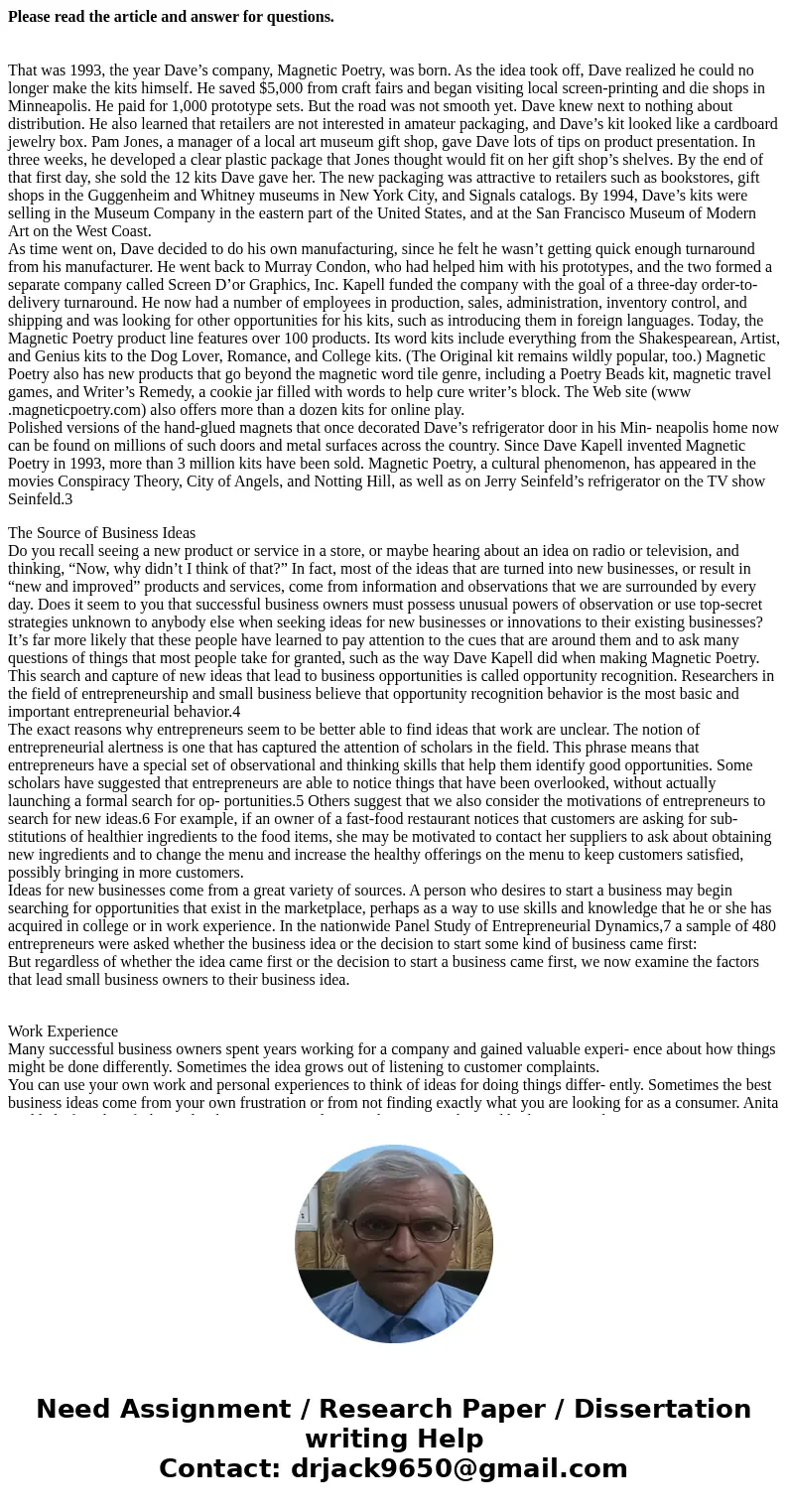
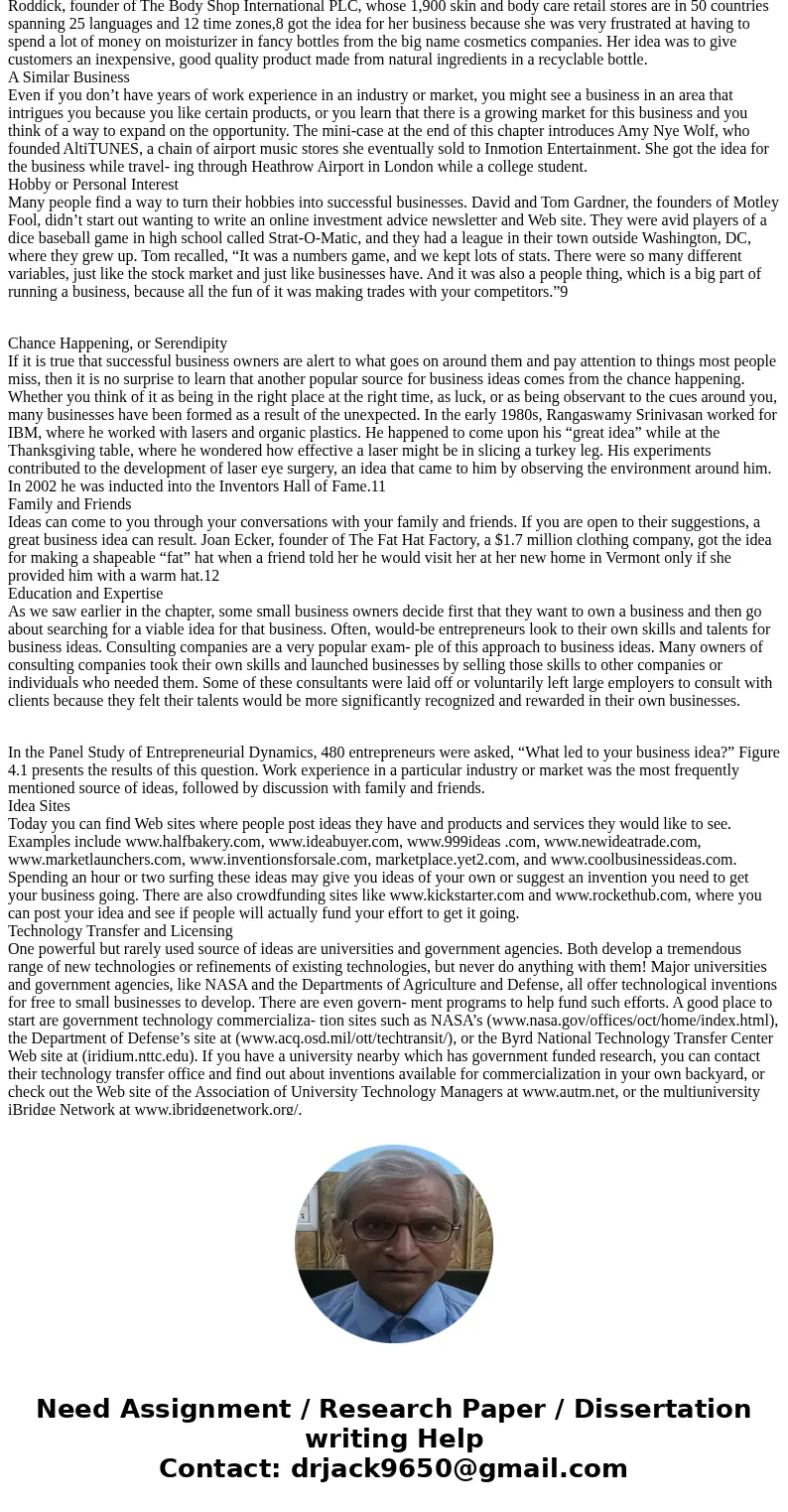
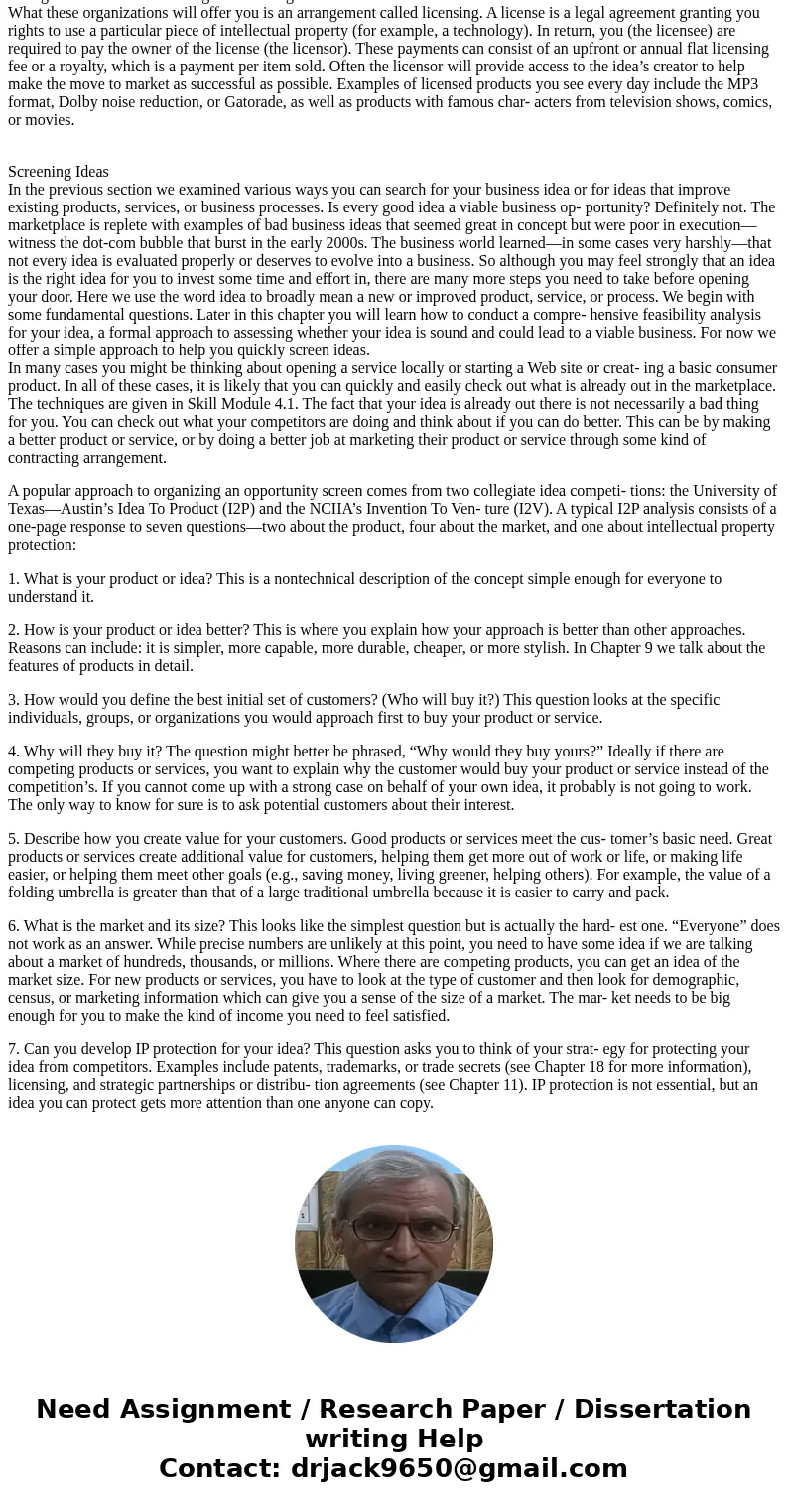
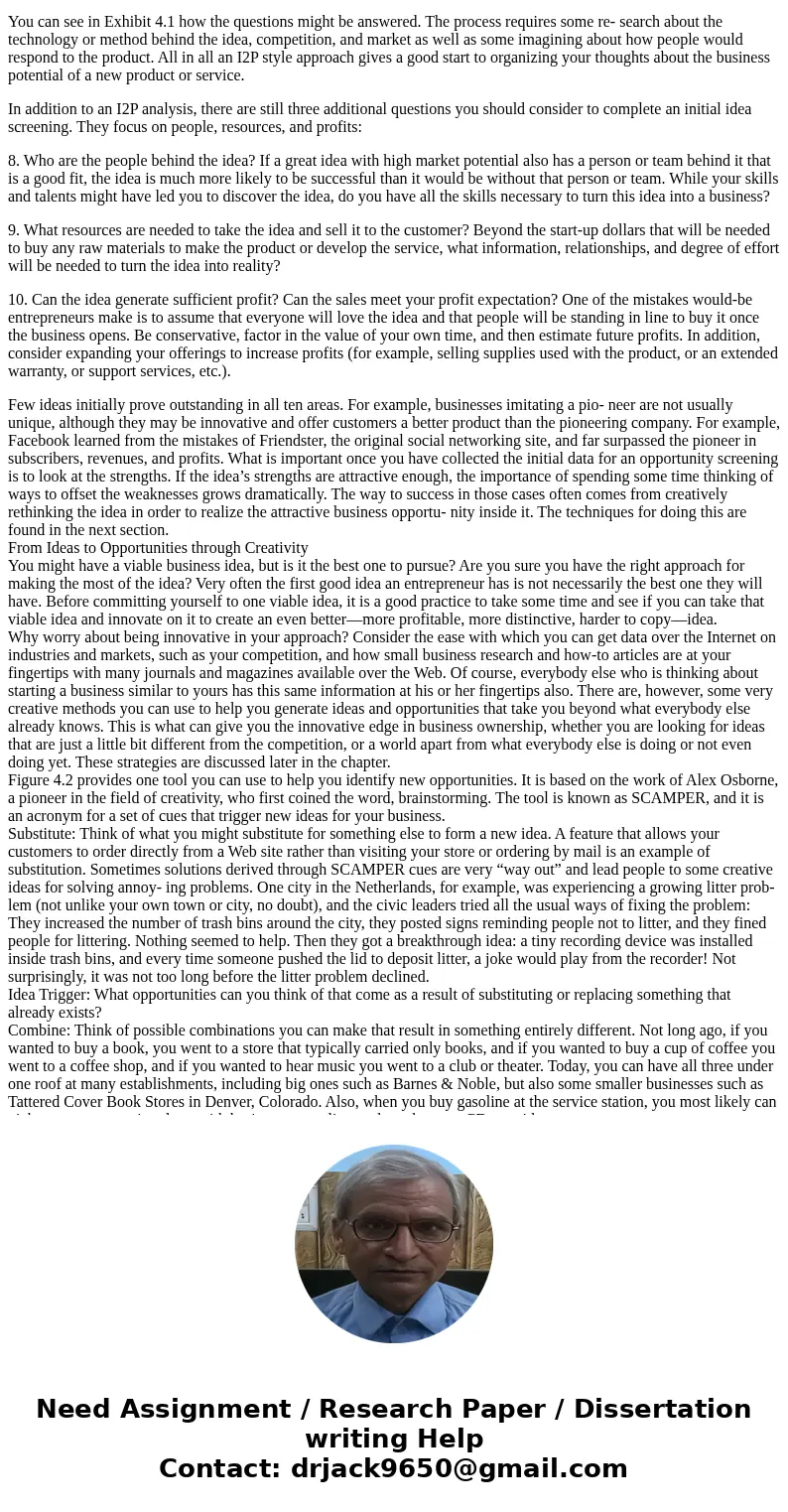
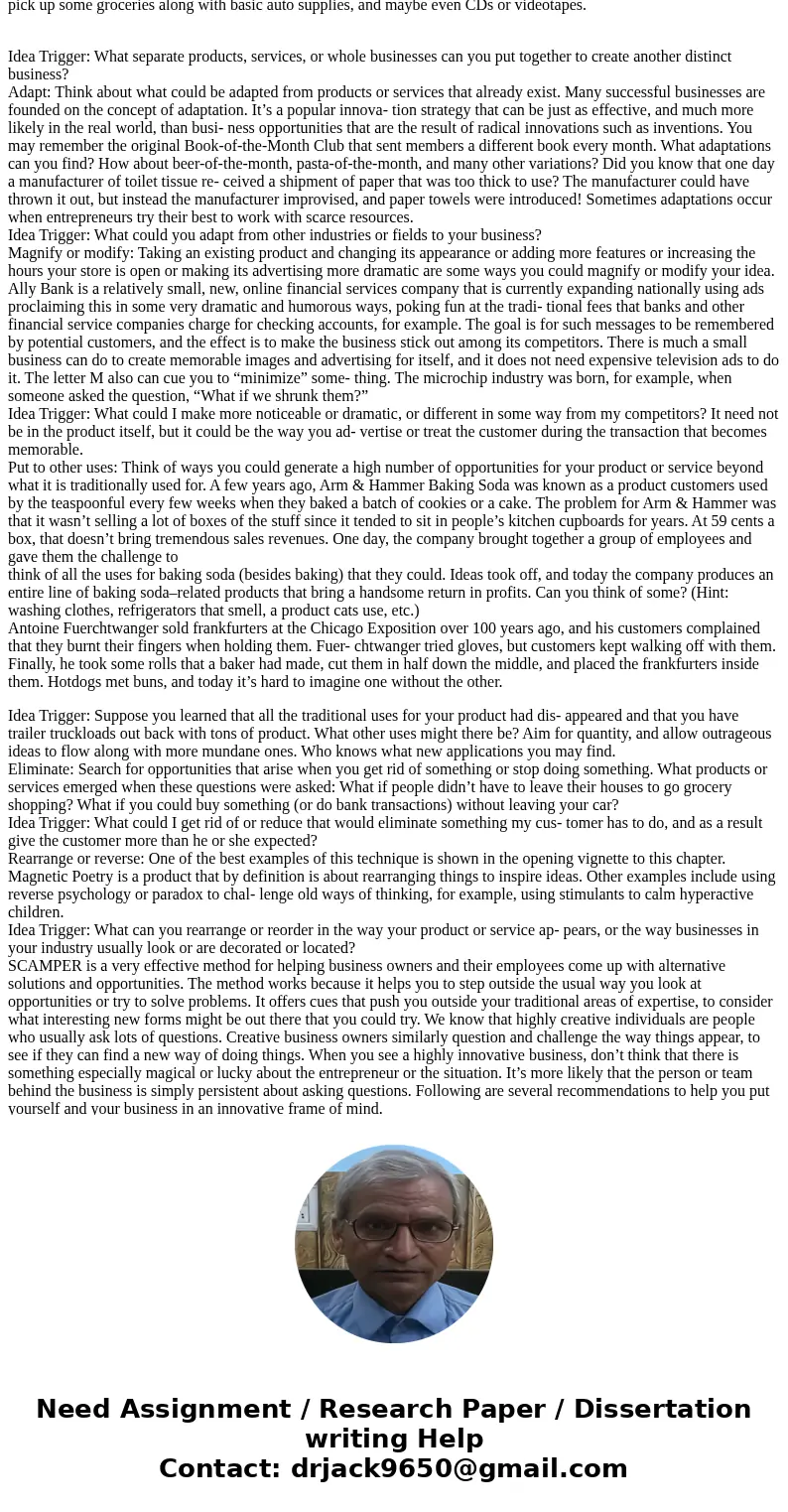
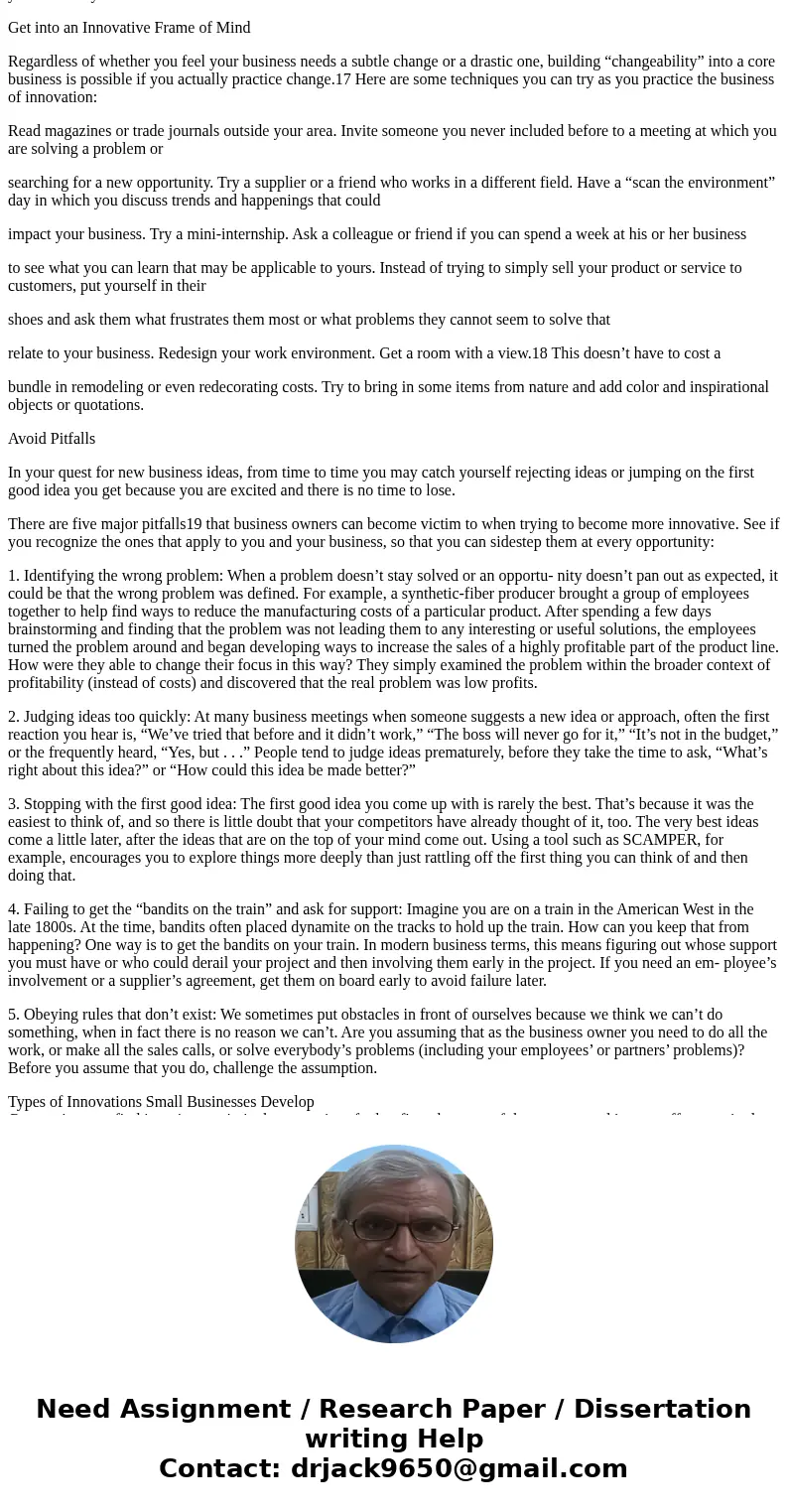
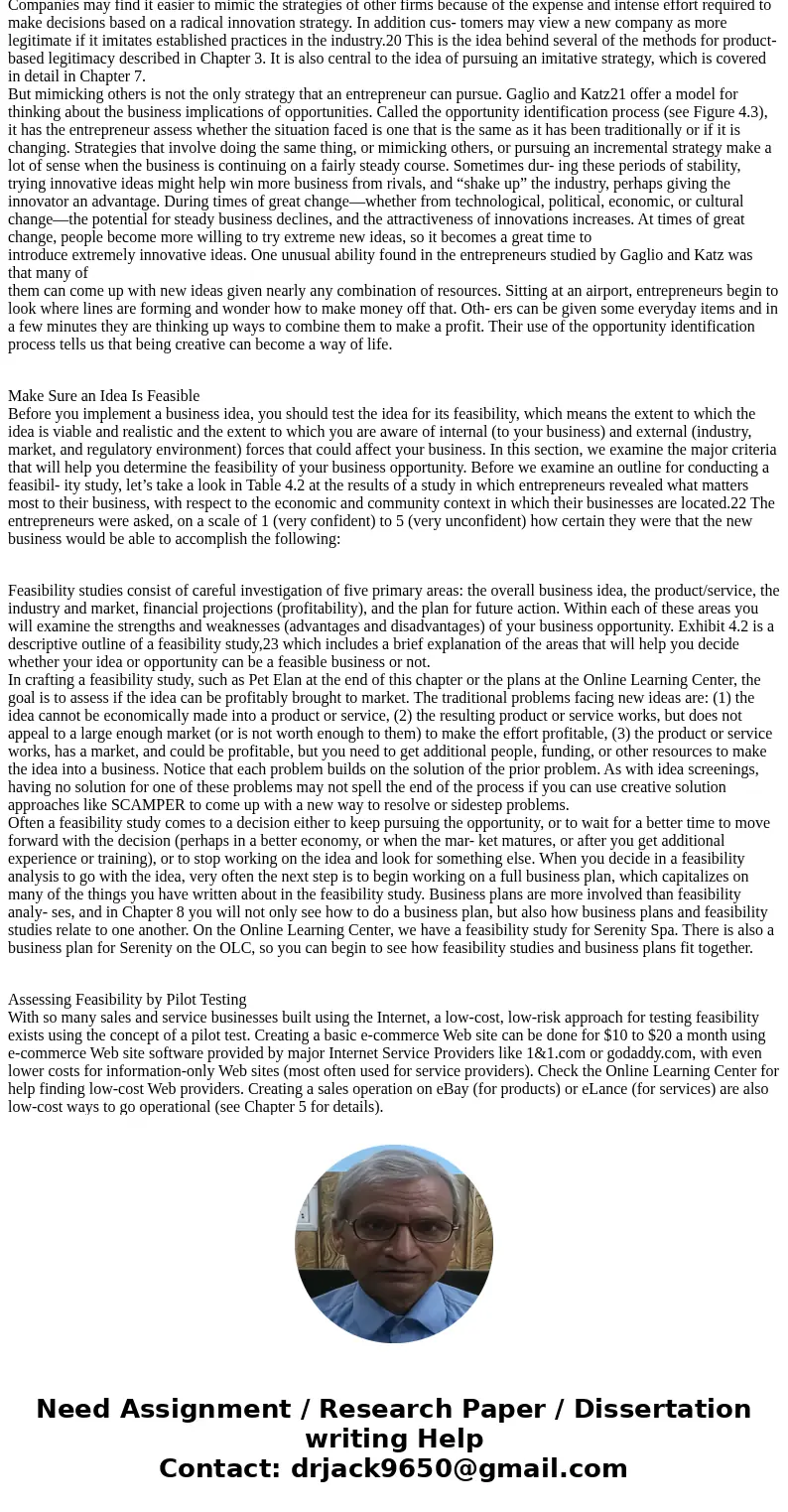
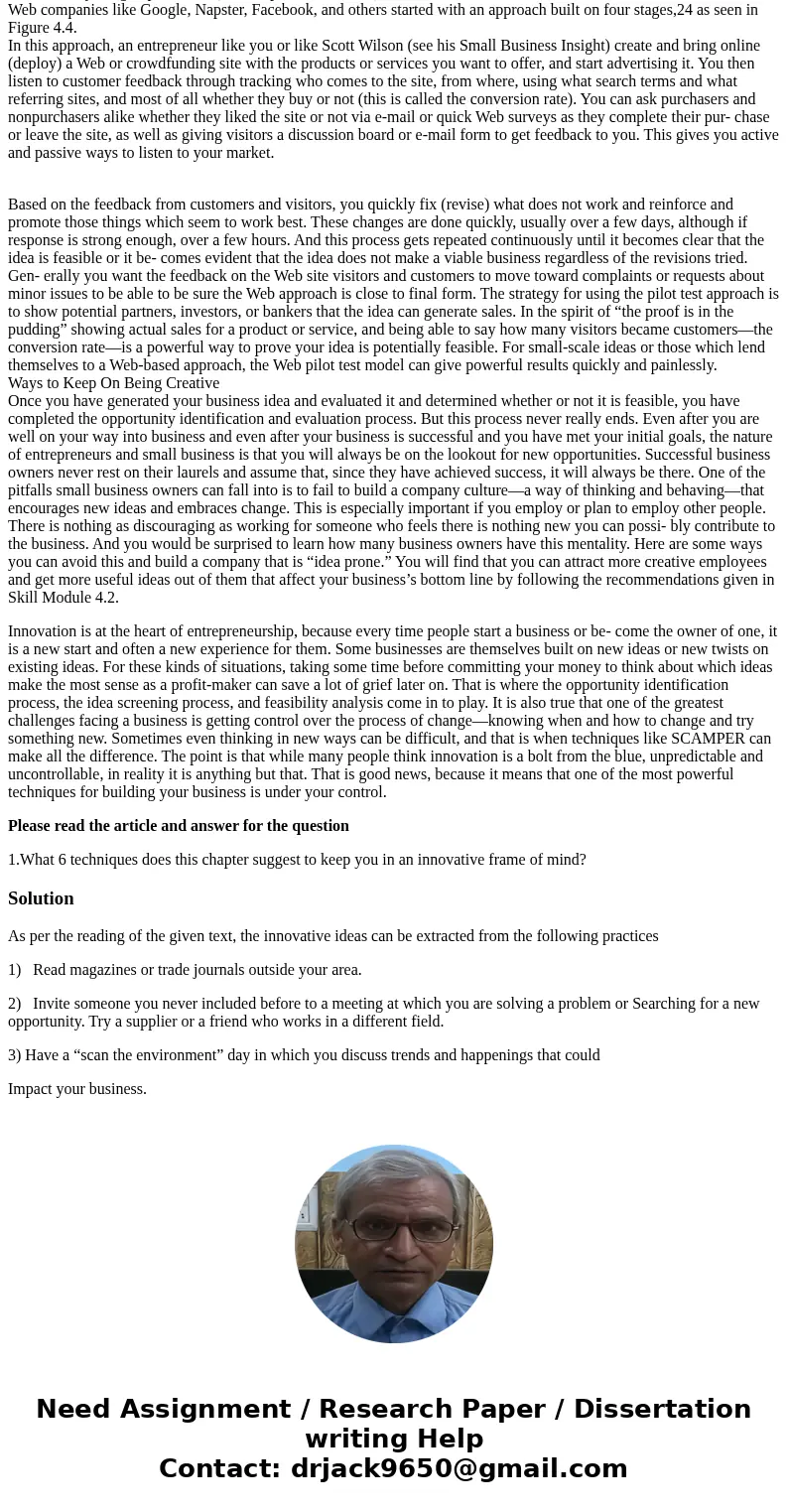
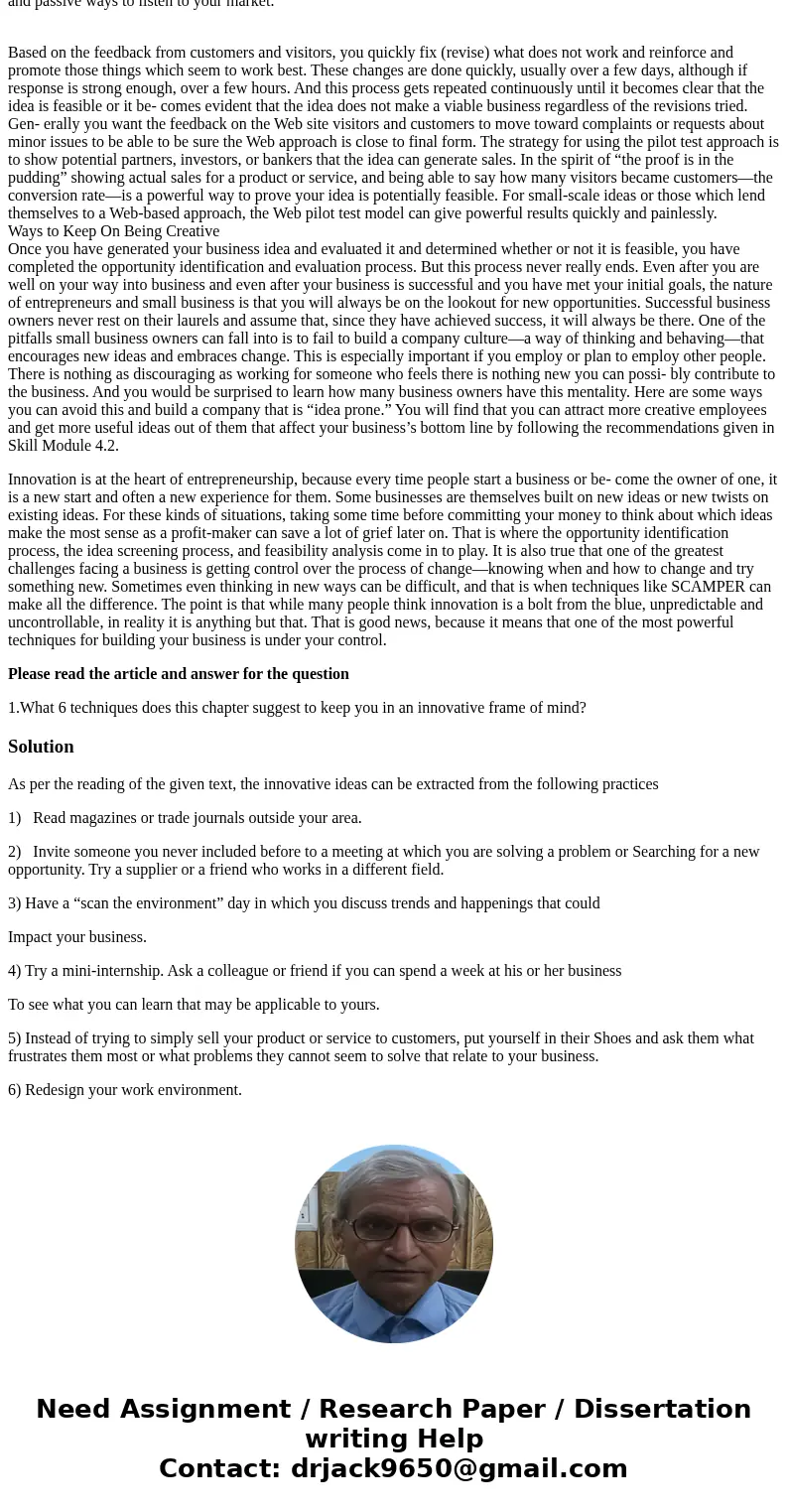
 Homework Sourse
Homework Sourse